Summertime is popular for travel, but what if you’re wearing braces? Are there any additional considerations to keep in mind when traveling with braces? Should you worry about getting through airport security? What if you wear Invisalign? Are there things to remember when traveling with Invisalign?
There are a few things to keep in mind when traveling with braces or traveling with aligners, but none of them should keep you from having a good time. Zombek Orthodontics offers a few helpful orthodontic travel tips to make your vacation a great one while keeping your orthodontic treatment on track.
The first step to a great vacation with braces is to schedule an orthodontic check-up before travel. We can check whether there might be any problems, such as a wire that could poke you or a bracket that might be slightly loose. We can replenish your braces rubber bands supply.
If you’re wearing Invisalign or Invisalign Teen, we can ensure you have enough sets to carry with you in case you need to change sets while you’re away.
We will do all we can to help you prepare for your vacation.

It’s a good idea to take a braces travel kit with you, not just for routine care but also for braces emergencies. Take this kit in your carry-on luggage in case any checked bags get lost.
You’ll need many of the same things for your Invisalign travel kit as you do for your braces travel kit.
In addition to the things you’ll need in the braces kit, you’ll want to add a couple of items for clear aligners. You’ll need aligner cleaning tablets to clean your clear aligners daily. If you don’t have any, it’s OK to use a solution of warm water and mild, clear hand soap. Be sure to rinse your aligners thoroughly afterward.
You should also carry two storage cases with you. One should store your clear aligners. The other should be a backup to hold your old aligners in case you switch to a new set during vacation. It can also serve as your main case in case you lose the other.
Remember, don’t throw away your old aligners if you switch to your new Invisalign trays while on vacation. You may need them if your new ones get lost or damaged.
What’s one of the best parts of visiting a new place? The food! We love trying new restaurants, foods, and drinks while on vacation. At Zombek Orthodontics, we want to encourage you to enjoy your vacation, and that includes trying new foods. Just be sure they fall within the rules for eating with braces.
Certain foods can damage your braces, and the last thing you want is a broken wire or popped bracket while on vacation. So, stay away from foods that are crunchy, sticky, chewy, and hard.
You should be careful of what you drink, too. Coffee, tea, dark sodas, red wines, and dark fruit juices can stain your teeth and clear braces over time. It’s OK to indulge once in a while as long as you rinse your mouth soon afterward to help prevent the stains from setting.
If you’re getting treatment with Invisalign, you don’t have to worry about these restrictions! Just be sure to rinse your mouth and clear aligners, and return them to your mouth as soon after eating as possible.
We do have a bonus tip: Drink lots of plain water! Water is not only good for your teeth and gums, but drinking water also helps you stay hydrated, allowing you to participate in all the fun activities you have planned. Water also helps keep your mouth moist, which keeps your teeth, gums, braces, or clear aligners cleaner. So drink lots of water!
No matter how well you plan a vacation, something is going to happen that isn’t part of the plan. What happens if you need emergency orthodontic care while on vacation?
Zombek Orthodontics has you covered. The first step is not to panic. The next step is to give us a call and explain the situation to us. We’ll be able to talk you through possible solutions. Hopefully, we can provide a temporary solution that will get you through the rest of your vacation without needing an emergency orthodontist visit.
Just in case, it wouldn’t hurt to research “orthodontist near me” once you arrive at your destination. That way, you have an idea where you might go should you need emergency treatment or repair. Look for an orthodontist who provides emergency care. We can work with whoever you find to get you the treatment you need.
A temporary fix may help you get back to your vacation without needing an orthodontist visit. Dental wax can cover a loose bracket or a poking wire. If the wire is poking out the back of your braces band, you may be able to trim it with a pair of nail clippers. We can talk you through it.
Finally, contact us as soon as you get home. We’ll get you into our Weston, FL, or Hollywood, FL, orthodontist office as soon as possible for any repairs.
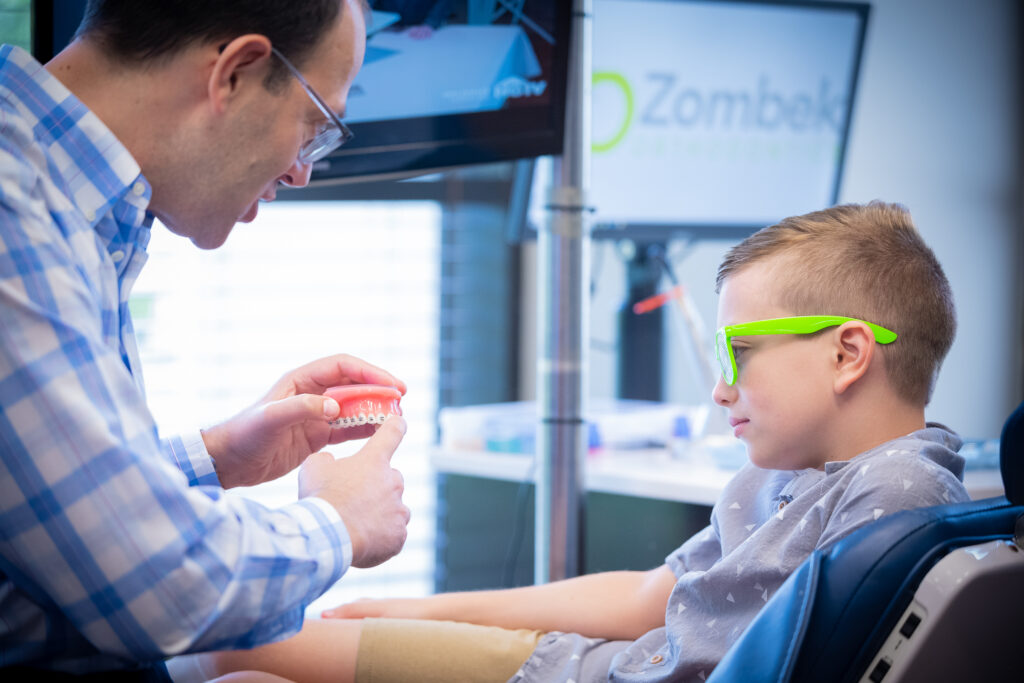
We know you want to see the answer to the most important question: How do I get through a TSA checkpoint with all this metal?
Rest assured, your stainless steel braces shouldn’t set off the body scanners at the airport. On the off chance it does go off (because you never know what could set those things off), just give the TSA agent a big smile while they pass the wand over you. You should be good to go.
Vacation is supposed to be fun. Worrying about your braces or Invisalign shouldn’t take the fun out of your trip. That’s why we encourage you to be prepared for any braces or Invisalign needs when you travel. These tips should help you have clear sailing on your vacation.
If you have any problems, schedule an appointment with Zombek Orthodontics once you return. We can take care of any issues and get your treatment back on track.
Once you are done wearing braces, it’s time to get retainers so your teeth don’t shift back to their original positions. Permanent retainers, also known as bonded retainers or lingual retainers, are glued in and cannot be removed. That has a lot of advantages, but it seems like flossing would be difficult.
Flossing with retainers is easier than you think! With the proper tools and techniques, you can floss quickly and easily with your bonded retainers. Zombek Orthodontics has a few tips on how to floss and care for your glued-in retainers.
A permanent retainer looks different from the removable plastic retainers you may know. The three most common types of retainers are the Hawley retainer, the Essix retainer, and the permanent retainer.
The Hawley retainer is made of acrylic, and wires fit over and around the teeth to hold them in place. The Essix retainer looks like a clear aligner. It is also made of acrylic and custom-molded to fit over the teeth. Both of these retainers are removable.
The permanent retainer, or lingual retainer, is not removable. It’s a wire that is bonded to the back of your teeth to hold them in place.
The lingual retainer is usually bonded to the back of the lower canines, but it also can be bonded to the back of the upper canines. The wire stretches across the back of the lateral and central incisors, holding all of the front teeth in place. Keeping those teeth in place usually keeps the other teeth in the proper position.
When you hear the word “permanent,” you think it’s, well, permanent. However, a permanent retainer lasts about 10-20 years before it usually needs to be replaced. This is because it can get bent or broken, or the bonding agent can wear out, causing the retainer to pop off the teeth.
We will check your retainer once you receive it. Your dentist can also check during regular cleanings to see whether there are any problems with your retainer. We can replace your retainer when the time comes.

What happens if your retainer breaks or comes loose? Permanent retainers are made of a very strong wire and are cemented to the teeth. They are made to be durable and to last for many years.
However, accidents can happen, and your retainer can break or come loose. It’s also possible to bend the wire, which will cause the teeth to move. The first thing to remember is not to panic! While it’s rare, it does happen, and Zombek Orthodontics is here to help!
If your fixed retainer is damaged or comes loose, the first thing you should do is call your orthodontist. The sooner we take care of your retainer, the less chance your teeth have to move out of place. We will bring you in for a repair or replacement.
You may think it will be difficult to floss with a permanent retainer. Flossing your teeth with a permanent retainer is easy with the right tools.
Floss threaders should be familiar to you. They are the needle-looking plastic devices we recommend to help you floss around the wires of your braces. Floss threaders are made of thin plastic and slide between your teeth and under wires, pulling the dental floss with them. You can also get floss threaders that are single pieces of plastic attached to the end of a piece of floss, so it’s all one piece.
To floss with permanent retainers, use the floss threader to pull the dental floss through your teeth and under the permanent retainer. Floss between your teeth, then lift the floss in the front while keeping it under the retainer.
Move to the next set of teeth and floss between them. Do this until all your teeth are flossed, then remove it from under the retainer. Floss the rest of your teeth as normal.
Here's a tutorial from the Weston orthodontist, Dr. Zombek, for how to floss with your permanent retainer!
Some people like to use water flossers, such as a Waterpik, to floss teeth. These can help dislodge food particles and plaque from around their retainers and between their teeth. However, they don’t have the scrubbing power of dental floss, so they shouldn’t be a replacement for it.
It’s OK to use a water flosser as a supplement to your dental floss, but be sure to floss with dental floss at least once a day. A water flosser can help keep your teeth and retainers clean between uses of dental floss.
There are other ways to care for your permanent retainer. Here are five tips to ensure that your fixed retainer lasts a long time.
Permanent retainers have a lot of advantages. They can’t be lost or forgotten like removable retainers, and you never have to worry about whether you’re wearing them long enough each day. Brushing and flossing with permanent retainers may seem challenging at first, but it’s actually easier than you think.
Zombek Orthodontics is here for you if you have any problems with your permanent retainers. Schedule an appointment with us in our Weston, FL, or Hollywood, FL, orthodontic office and we can help you out. We know how hard you worked to get that beautiful smile. We want to ensure you properly care for your teeth and retainers so you keep that smile beautiful!
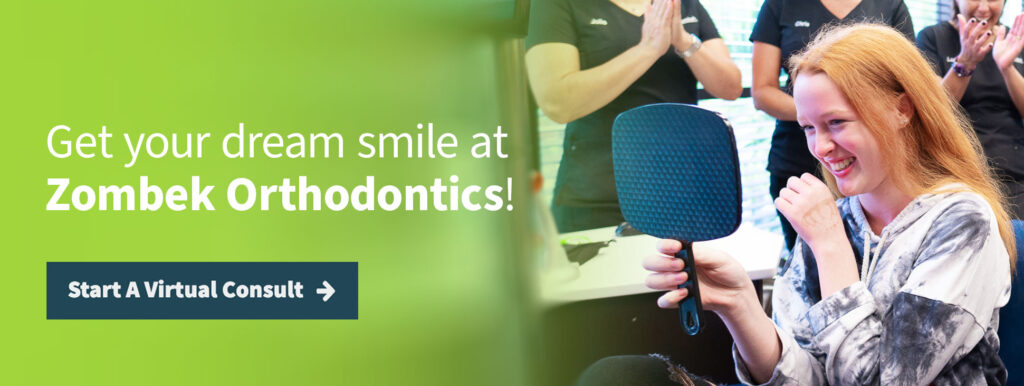
We all know the best part about Halloween is that sugary bounty. It’s a bit different if you are a braces wearer, though. So what Halloween candy can you eat with braces?
Plenty of Halloween braces-friendly candy is available, but there is also candy you shouldn’t eat. That candy can damage your braces. Zombek Orthodontics wants you to enjoy the holiday and the “safe” types of candy.
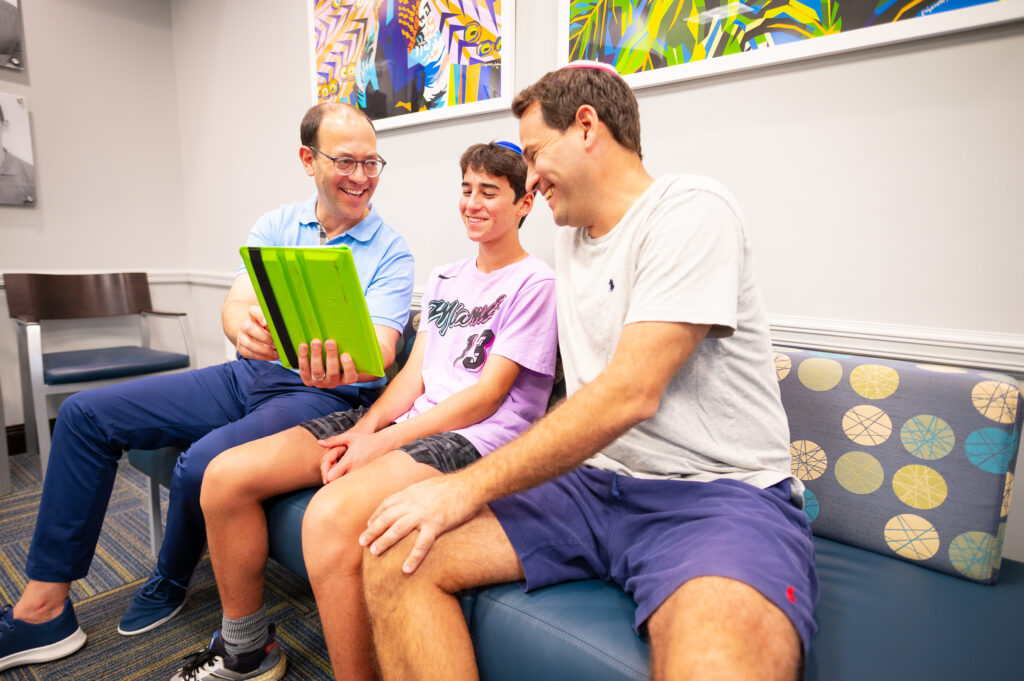
Some Halloween sweets are more trick than treat. Sticky, hard, or crunchy food and candy can get stuck in your braces and damage the brackets and wires.
Here are some of the Halloween treats to avoid eating with braces.
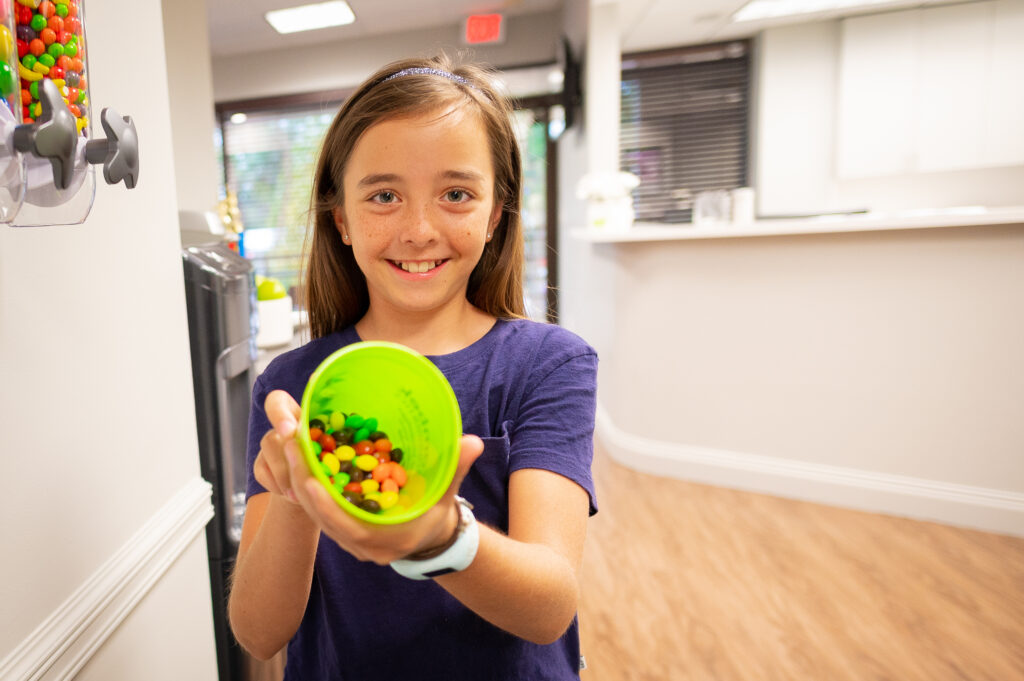
Do you like Reese’s Cups or M&Ms? Skittles or KitKats? What candy can you eat with braces?
Here’s a list of some of the best Halloween candies that won’t result in an orthodontic emergency for you or your kiddo.
These are just a few delicious candies you can eat with braces!

Do you want to know if a specific candy is good for your braces? Here’s a guide to some of the most popular treats for Halloween.
Unfortunately, you should avoid eating gummies with braces, as well as gummy bears and gummy worms. Save those for when you get your braces off!
You can have some chocolate with braces! Check out the list above for which ones are good and which ones to avoid!
Yes, just brush your teeth well so the marshmallows don’t stick to your brackets.
Unfortunately, you should not eat Skittles with braces. The hard shell and chewy inside are a recipe for a braces disaster.
While Sour Patch Kids may seem less gummy than most chewy candies, they can still cause damage and should be avoided during orthodontic treatment.
Airheads will definitely hurt your braces’ brackets and wires. On a chewiness scale from 1-10, they’re a solid 10.
Good news! There are somewhere between 11 and 61 flavors of M&Ms now! While you need to be careful of add-ins like nuts, pretzels, and caramel, plain M&Ms and soft (not sticky!) options like peanut butter are braces-safe. You want the chocolate that melts in your mouth!
Between the gooey caramel and crunchy cookie, this is a bad one for your braces.
Sticky and hard candies like Jolly Ranchers will cause bracket or wire damage to your braces.
Yes! Break off a piece of that KitKat and enjoy those chocolate-covered wafers!
Starbursts are a no-go with braces. They’re hard and chewy and will definitely hurt your wires and brackets.
Wait to eat these till after your orthodontic treatment, sadly.
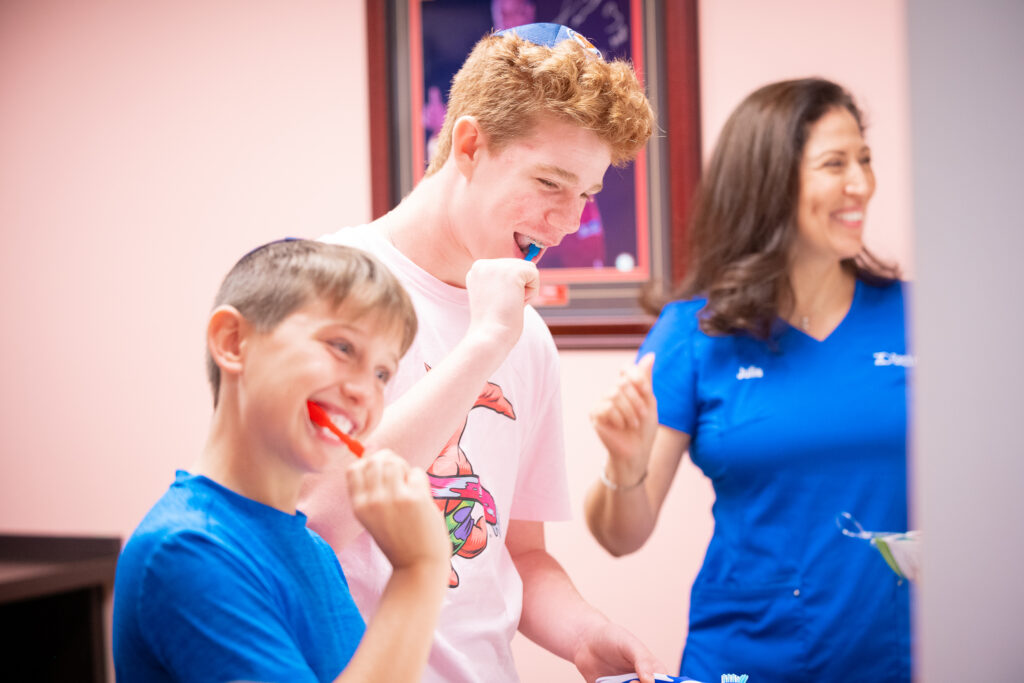
We want you to enjoy Halloween, but we also want you to have healthy teeth! Here are a few tips for enjoying Halloween candy with braces without sacrificing your oral health.
Even with prevention, braces accidents happen. Contact Zombek Orthodontics if you notice a loose wire or bracket or if you break a wire or pop a bracket. We will get you in for repairs!
If you end up with a bunch of candy you can’t eat, bring it to Zombek Orthodontics! Every year, Zombek Orthodontics offers a Candy Buyback in the first week of November to all our patients. Trade any unsafe candy for cash and join us in supporting a great cause — Kakes 4 Kids!
The non-profit organization, Kakes 4 Kids, celebrates the birthdays of over 300 foster and underprivileged children in South Florida. They organize personalized birthday celebrations for every child!
Happy Halloween from Zombek Orthodontics!
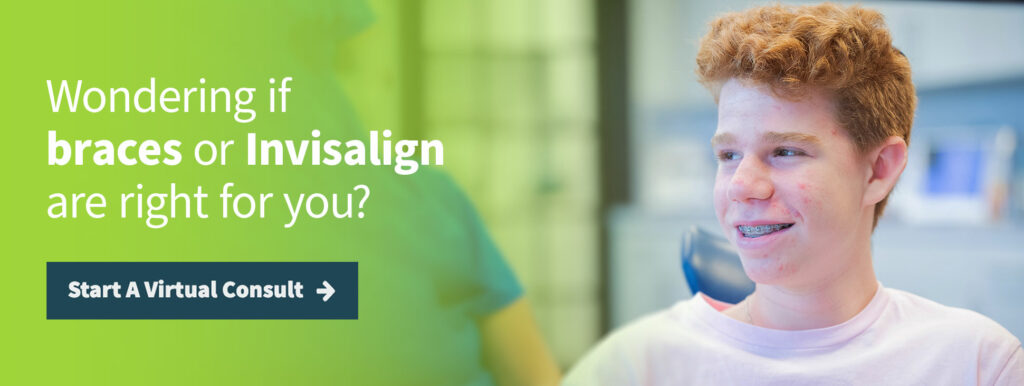
Teeth! We all use them, but most don’t know much about them. Why do we have so many teeth?
Why do we get baby teeth first instead of adult teeth right away? How do human teeth stack up against other animal teeth?
Learning about teeth anatomy helps us understand how teeth help animals (and people) stay safe and strong. It can also help us appreciate why keeping our teeth straight and healthy is essential.
While your teeth are similar to your bones, they are different.
Bones have a thick outer layer with a soft inner layer called marrow. Teeth also have an outer shell with a soft interior but not marrow. Teeth consist of three main layers: enamel, dentin, and pulp.
The tooth enamel is the hard outer shell that protects your tooth. The dentin is the part of the tooth that protects the pulp and gives your enamel a good foundation. The pulp is the living tissue where you’ll find nerves and blood vessels of the tooth.
That means your teeth are living, and you must practice good oral hygiene to keep them healthy. Tooth decay, gum disease, and infection can weaken and eventually kill a tooth. That’s why at Zombek Orthodontics, we talk with you about the importance of brushing and flossing regularly!

Humans have four main types of teeth: Incisors, Canines, Premolars (bicuspid teeth), and Molars. Let’s look at the differences.
Your lateral and central incisors are the teeth located at the front of your mouth. You have four on top and four on the bottom. The incisors bite and chop food, like when you bite into an apple or corn on the cob.
The long, pointy teeth on either side of your incisors are the canines. Humans have four canines — two on top and two on the bottom. Canine teeth tear food, including meat.
We get premolars for the first time when we get our permanent teeth (babies don’t have premolars.) We have eight premolar teeth as adults.
There are two premolars located on each side, on top and bottom. The premolars sit behind the canines and help grind the food pulled apart by the canines and incisors.
The molar teeth are your big back teeth. They grind your food until it’s broken down enough to swallow. How many molars do you have?
Most adults have 12 permanent molars, three on each side, top and bottom, if they have all their wisdom teeth.
Wisdom teeth are the common name for the third molars that come in once we reach adulthood. Most people have four wisdom teeth, but not all! The Dental Research Journal reports that up to 37% of the population is missing wisdom teeth! Do you have all of yours?
It’s OK if you don’t have all of your wisdom teeth. The molars you do have are 100% up to the task.

You may think all teeth look and work alike in animals, but that’s not true! Carnivores, herbivores, and omnivores have very different teeth. Why? It’s all about diet!
Carnivores, like wolves, otters, tigers, and bears, eat only meat. They have sharp teeth throughout their mouths. Usually, meat eaters have lots of space between their teeth to keep debris from getting trapped there. Raw meat contains many dangerous bacteria that could quickly rot their teeth, a serious threat to survival in the wild.
Each type of tooth helps the carnivore in a unique and important way. Carnivores’ front teeth, their incisors, are pointed to help them catch and tear into their prey.
Carnivores’ large canine teeth help them fight their prey and each other and tear and shred meat from bones.
A carnivore’s molars are like knives, chopping their food into pieces small enough to swallow. Because carnivores have extremely acidic stomachs, they can quickly swallow large chunks of protein without bothering to chew.
Most of us expect that the big difference between carnivores’ teeth and omnivore teeth will be their canines. After all, why would animals like giraffes, hippos, and rabbits, which eat only plants, need teeth that tear meat?
Turns out many herbivores have canines. They have canines on the bottom, while carnivores usually have them on the top, too. It turns out that herbivores need a few sharp teeth.
While most herbivores need some sharp teeth, they don’t need the pointy front teeth (called incisors) that carnivores do. Instead, their incisors are chisel-shaped, which helps herbivores gnaw through hard seeds, woody plant stems, and tough grasses.
Many herbivores have a large space between their incisors and the rest of their teeth, called a diastema. Herbivores use this space as a sorting area. Their tongues find the inedible or thorny pieces and spit them back out, which protects the rest of the mouth.
Herbivores also use this space to reposition their food over and over again while they chew. Herbivores use their broad, flat molars to crush and grind their food into a paste. This allows for easy swallowing and digesting in the stomach and intestines.
Omnivores have a mixed diet. They eat both meat and plants. They need versatile teeth to take advantage of all kinds of food sources.
Omnivores’ incisors are sharp at the tip but wide, not pointy like carnivores’. This wide, sharp edge lets omnivores slice off chunks of meat, and it cuts plant material like a knife.
Omnivores’ molars can multi-task too. They’re wide like an herbivore’s molars so that they can grind up food. But unlike herbivores’ molars, their surface has multiple sharp points. Grinding and chopping help omnivores crush their food relatively quickly.
Quick eating is important for any predator, but unlike carnivores, omnivores can’t effectively digest meat unless it’s well-chewed.
Like herbivores and carnivores, many omnivores have long, sharp canines. These help omnivores catch prey, compete for dominance, and defend themselves, their territory, and their young against predators.
Humans make many different choices about what we do and don’t eat. Our teeth make it possible for us to eat an omnivore’s diet or any diet.
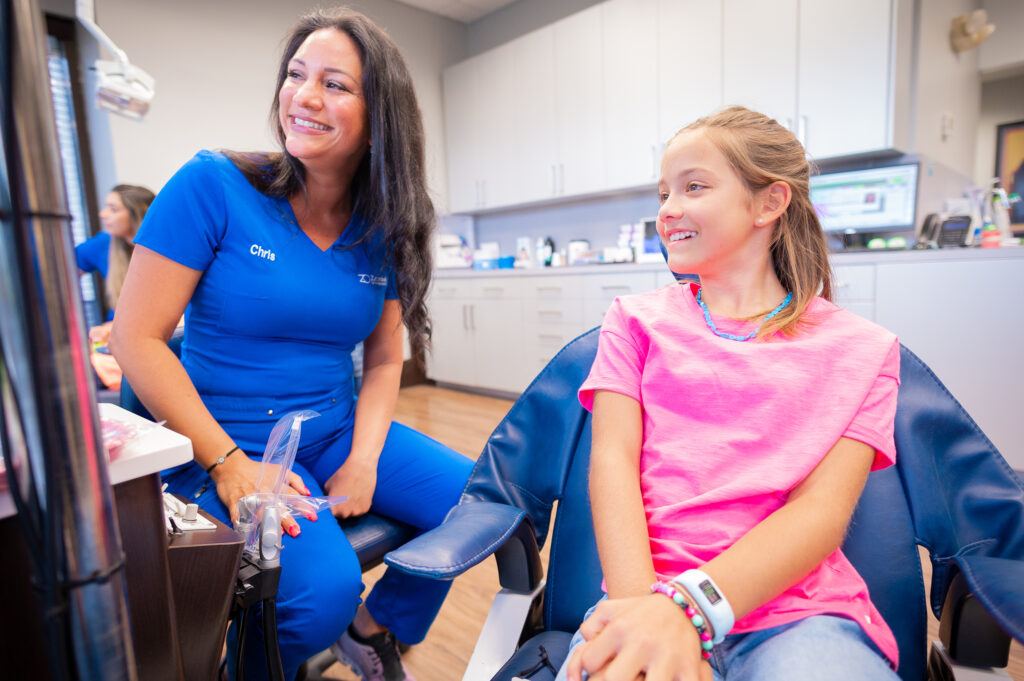
The short answer to this question is that we grow! Babies’ small heads make birth possible, but by age 1, our heads are already about 87% of their adult size. Baby teeth, also called primary teeth, deciduous teeth, and milk teeth, help us develop as we grow.
Baby teeth start appearing around six months of age. They help us develop important skills like speaking and eating while our heads and jaws grow.
How many teeth do kids have? 20! They have eight incisors, four canines, and eight molars.
Permanent teeth replace those and add eight premolars and four wisdom teeth. A total of 32 permanent teeth!
Permanent teeth are developing in our jaws even as our baby teeth are first erupting from our gums. Eventually, children need bigger teeth to eat properly, so baby teeth fall out.
Do baby teeth have roots? Yes, they do. But those roots dissolve, allowing the baby tooth to fall out and the permanent tooth to take its place.
By the time we’re teenagers, most permanent teeth are in, except for a few back molars. Wisdom teeth come in between ages 17 and 24, if at all.

Adult teeth should last a lifetime. But it’s natural for teeth to wear down, shift, or discolor slightly over time. Healthy teeth are essential to the survival of lions and squirrels, and they’re necessary for you, too! Throughout your life, your adult teeth help you to chew properly and speak clearly.
Your teeth wear down more quickly with misaligned teeth. A bad bite also increases your chances of gum disease, tooth decay, and even tooth loss. Orthodontic treatment realigns your teeth, making them easier to clean and more likely to last for the rest of your life.
Zombek Orthodontics is here to help you keep your smile healthy and strong for a lifetime. We offer braces treatment and Invisalign clear aligners to straighten your teeth.
Start with a virtual consult or schedule an appointment in the Weston, FL, or Hollywood, FL, areas. See how we can keep your smile beautiful and your teeth healthy!

 This site’s strategy, design, photo & video were created by the marginally-above-average folks @ Clear Partnering Group.
This site’s strategy, design, photo & video were created by the marginally-above-average folks @ Clear Partnering Group.